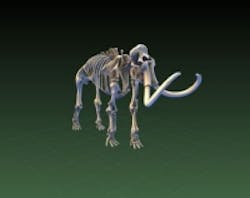Smithsonian creates 3D model of mammoth, other historical artifacts
As part of theSmithsonian X 3D project—in which 3D laser scanners are used to create 3D digital images of the museum’s historical artifacts—digital models of a mammoth skeleton, the Wright Brothers’ aircraft, an entire dinosaur exhibit hall, and a number of other artifacts have been created.
The Smithsonian uses a Faro Edge ScanArm ES to create its 3D models of the ancient artifacts. The ScanArm is a seven-axis measurement system with a fully integrated laser scanner which enables users at the Smithsonian to collect simple point variations with the ScanArm’s hard probe and laser scan sections requiring larger volumes of data. It features new software algorithms which automatically adjust the scanning parameters for a variety of surfaces, and a new high dynamic range mode enables users to scan materials with high contrasting colors simultaneously.
Faro’s ScanArm features a scan rate of up to 45,120 points/s and an accuracy of ±35 µm (±.0014 in.) It also features a depth of field of 85 mm (3.35 in), an effective scan width of 53 mm (2.09 in, near field), and 90 mm (3.54 in, far field), and a 752 points/line rate. In addition, it features a 60 fps frame rate (60 fps x 752 points/line = 45,120 points/second.)
The Smithsonian’s X 3D project has now seen the 3D scanning and digitalization of 20 artifacts, according to a Sky News article. The purpose of the project is to not only digitize and document its artifacts, but to also virtually transport its educational exhibits to homes and classrooms around the world. Specifically, the Smithsonian’s 3D explorer enables users on the web to examine exhibits, including zooming in and rotating the artifact at will. (Check it out here.)
It doesn’t end there, however, as the digital 3D images can be combined with 3D printers to create copies or replicas of specific museum exhibits. A 3D printed model of former U.S. President Abraham Lincoln’s face is shown in the video in the Sky News article, for example.
In addition, the technology can be used to document archaeological or paleontological sites and preserve skeletons in 3D before they need to be moved. A Smithsonian team recently flew out to Chile to scan the skeletons of five-million-year-old fossilized whales, a practice (3D scanning a discovery site); the team predicts, in time, will become standard.
View the Sky News article.
View more information on the Smithsonian X 3D program.
Also check out:
(Slideshow) 10 different ways 3D imaging techniques are being used
UAVs create 3D model of the Matterhorn
3D scans show entire fossil of baby dinosaur skeleton
Share your vision-related news by contacting James Carroll, Senior Web Editor, Vision Systems Design
To receive news like this in your inbox, click here.
Join our LinkedIn group | Like us on Facebook | Follow us on Twitter | Check us out on Google +
About the Author

James Carroll
Former VSD Editor James Carroll joined the team 2013. Carroll covered machine vision and imaging from numerous angles, including application stories, industry news, market updates, and new products. In addition to writing and editing articles, Carroll managed the Innovators Awards program and webcasts.
